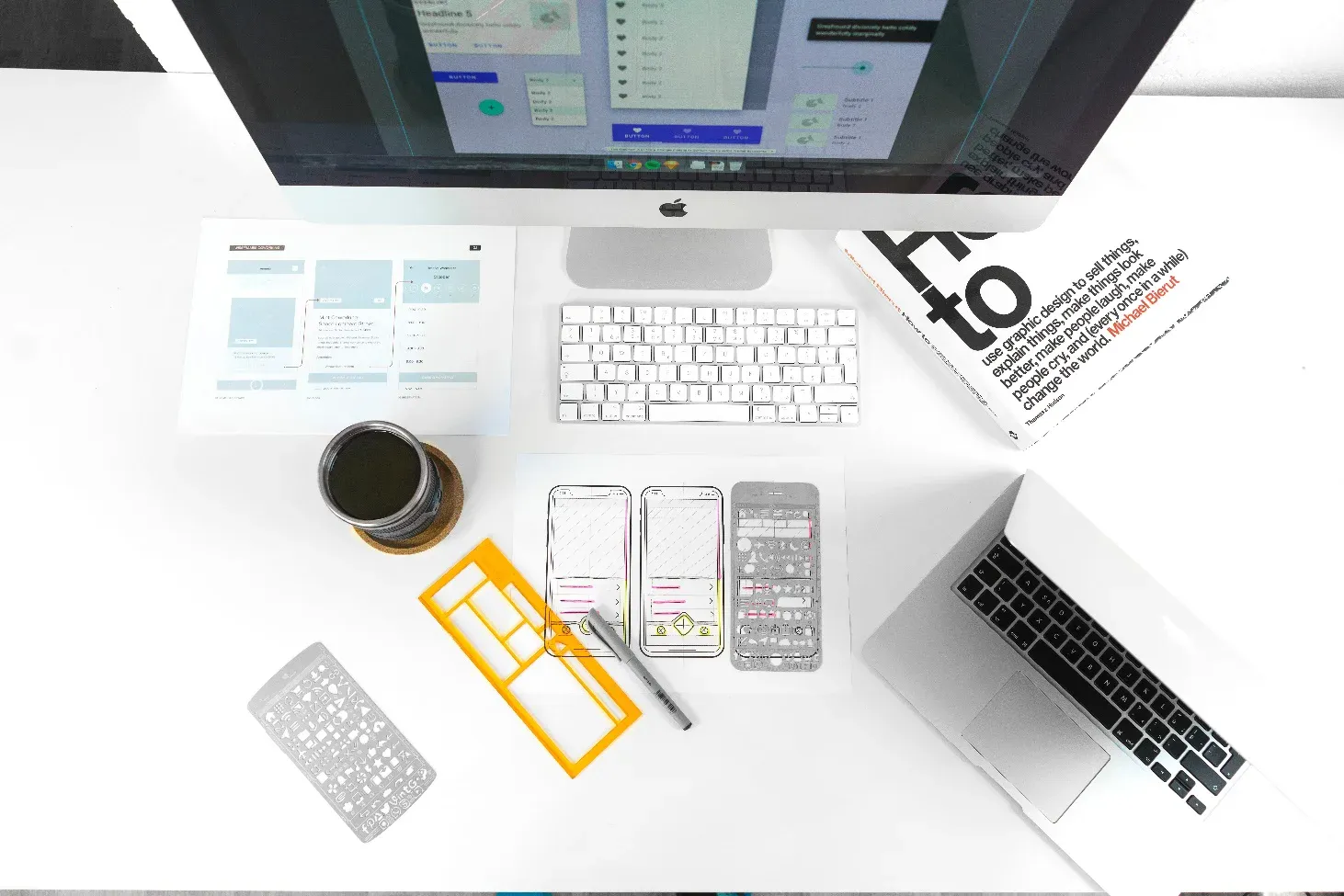
Get a UI/UX Designer Job Without Experience: Ultimate Guide
Every year, the demand for interface design increases significantly. With an average income of $80,000 to $103,000 annually, the UI/UX designer position frequently ranks among LinkedIn's top jobs. Currently, there are about 11,000 opportunities on the platform, the bulk of which are entry-level UI/UX designer positions.
Learning and mastering as many talents as possible, whether a novice or a more or less experienced designer, is one of the ideal methods to make a name for yourself in the profession and show your skills to future employers.
Below we've listed the main recommendations, soft and hard skills that are essential in the work of a UI/UX designer. This list is also helpful for self-evaluation and resumes writing. Go over the list and mark your proficient talents with an A+. A step-by-step guide on how to gain employment as a designer without experience was also included.

Start Your UI/UX Design Career from Scratch: 5 Things You Should Know
1. Get The Right Education
Before we move on to hard and soft skills, let's deal with the introduction to the profession. If you want to get into user interface design without any work experience, you must first get the appropriate education. Of course, it doesn't have to be a university degree. However, there are special programs in design, and education in a field such as human-computer interaction (HCI) or psychology is good for you, which will teach you how to do user research and design intuitive interfaces. However, courses or self-study are also sufficient for success.
Regarding courses, they will help you gain basic knowledge, but it is essential to plan ahead and choose a course that will fit into your schedule. Many of these courses are available in self-study mode, ideal for those with little free time. For self-study, tutorials on YouTube, now a huge number of them, can help.
Related Article: Top 19 Best Online UI/UX Design Courses You Must Take
2. "Hard" Skills of a UI/UX Designer

Image from UX Store on Unsplash
UX research
One of the key abilities that will assist a designer in producing a product with a great user experience is UX research, from studying quantitative data to interviewing people. You should be able to choose participants, capture the outcomes of unstructured dialogues, and be knowledgeable with usability testing techniques like card sorting and heat mapping.
Visual design
UI/UX designers should thoroughly understand visual language, from color theory to layouts. Ensure you understand the reasoning behind each design aspect in your portfolio, despite this being one of the simplest talents to learn.
Structure and prototyping
Imagining how a product will look is a key component of product development. Develop your prototyping and product structuring abilities aggressively to persuade your clients of your proficiency.
To provide a straightforward and useful user experience, you need to know which features to display, where to place them, and how to arrange them. You must test the functionality of the app, ensure that the system and the user work well together, and ensure that it is suitable for release when prototyping.
Understanding of design tools
You must possess an in-depth understanding of one or more design tools in order to be a proficient UI/UX designer. You should be knowledgeable about common design applications like Adobe XD and Figma.
Take refresher courses to learn these programs and put them to use. Online, there are a ton of free video guides. Using these tools, you may build interactive prototypes and construct a user interface design structure.
Typography
Typography is an important skill every UI/UX designer should have in the digital age. Typography can grab a user's attention by defining and highlighting content in a design. You need to know when to choose a serif or sans serif font, whether to use italics or bold, how to make the text more legible, etc. If you want to improve your typography skills, reading specialized blogs or article review examples about typography can be a great way to learn from others' experiences and insights.
3. "Soft" Skills of a UI/UX Designer
"Soft" talents are sometimes undervalued, although they can be crucial in selecting a candidate because they are closely linked to personality, which greatly impacts job prospects and progress. Let's look more closely at the abilities that UI/UX designers need.
Curiosity
The UI/UX design industry is continuously changing and seeking out new, creative ways to make the world a better place. Every designer's soft talent includes a healthy dose of curiosity and the drive to study things outside of the classroom. You can quickly become more adept at this skill by often asking yourself fresh questions and taking various approaches to difficulties.
Communication
One of the most crucial abilities needed for practically every job is communication. Even if you are the best designer, you will struggle to get the intended final result if you don't communicate with your team, employers, or clients.
You must therefore speak more frequently, voice your opinions, give feedback, and describe your approach to the team whether you intend to begin your career at a startup or on a major project.
Flexibility
Designing UI/UX involves innovation and ongoing change. As a result, you must be adaptable enough to change with industry developments. You should also be prepared to handle multitasking, taking on new duties, scheduling adjustments, etc.
Collaboration
A UI/UX designer collaborates with clients, developers, and other team members. In order to produce the greatest product possible, a professional should solicit and give feedback on ideas, look into potential fixes, and consider everyone's input and experience.
You Might Also Want to Know: How to Overcome Design Inspiration Blocks?
4. Guidelines For Finding A Job As A Designer With No Experience
Landing your first job as a UX designer can be challenging, especially if you have no experience in the field. However, extra effort, strategic communication, and careful attention to portfolio building will allow you to land your first job. So, check the main points:

Image from Ivan Samkov
Learn and improve your design skills
Finding a promising job requires studying the fundamentals of UI/UX design, regardless of your level of expertise as a designer. Thus, you must first develop your abilities, practice often, read several books and articles on design and human psychology, or enroll in accredited online courses. The latter choice will aid in your methodical and, most crucially, quicker learning. Decide on the option that is most comfortable for you.
Practice skills through real work
You develop into a superb professional through practice. To become a successful UI/UX designer, you must use your abilities on genuine projects. You can get started by doing projects as a volunteer or an intern, working as a freelancer, or even redesigning old or unsuccessful work for businesses or brands. Also, completing these daily tasks for your portfolio will advance your talents.
Build your portfolio
If you're looking for a UI/UX designer job with no experience, creating a portfolio showcasing your skills and best work is crucial. This will help you stand out from other candidates and demonstrate that you have the necessary design skills.
The design portfolio should reflect your personality, design style, and the type of work you want to do. It should be visually pleasing and easy to navigate so recruiters can quickly find the information they need.
A good portfolio should feature a variety of projects that illustrate your skills and show how you've used different design approaches. It should also include a landing page that will make it easier for recruiters and hiring managers to find your most relevant work.
You'll also want to demonstrate your team player and communicator skills. Including project details, such as your role in the project and your communication with other designers, will help reviewers understand your ability to collaborate.
Likewise, your portfolio should emphasize visual design, content, and information design. It's also important to show you know how to work collaboratively with clients.
Creating and updating a portfolio can be challenging, but it can be an important part of the process. You can use platforms like Dribbble to post your portfolio and easily update it when you create a new project.
A professional-looking portfolio site can help you look more professional and stand out from other candidates. It's also a great way to network and find potential employers.
More Thoughts on Kickstarting Your Design Portfolio.
5. What Does The Company Want From a Junior At A UX/UI Designer Interview?
You need to prepare yourself for the fact that you are going through one of the hardest stages when trying to get your first job. The fact that you have completed the best courses or received an education is good, but it is no substitute for real experience, and the threshold for entering the design profession is quite low; courses graduate hundreds of designers every month, so the competition will be high at this stage. Besides, a detailed understanding of soft and hard skins is not enough to succeed. So, in the last chapter, we will summarize the requirements for the candidate according to our observation and experience.
Adequacy
This is the first thing people usually pay attention to. Yes, it can be subjective, but you have to be liked as a person. Whatever you say, you are applying for a role in a team with which you will have to interact quite closely, and no one wants toxicity that poisons the atmosphere.
No one owes you anything for completing the course, sorry. Therefore, an objective assessment of your level, understanding of your weaknesses, and the desire to improve them will always add a couple of points to your score.
Motivation
What drives the candidate? Are they ready to improve their professional skills? Will they back down at the first difficulty?
After all, it's not profitable for anyone to hire a fly-by-night team. You train them, spend time and effort, and they turn around and leave.
But if the candidate knows the main events in the design community, reads some blogs, and designs for the soul, that's another matter.
Behavior in non-standard situations
They want to hear how you demonstrate logic and deduction here. You may be asked to solve a hypothetical situation.
For example: You have been given a project started by another designer to complete. And then you notice a mistake in his layouts. What will you do?
At this stage, there are no definite right answers, the main thing is to show the train of thought in which you minimize risks.
In our case, the worst answer would be: I'll take it and fix all the mistakes! But what if they are not mistakes at all? What if they are meaningful decisions dictated by some constraints you are unaware of?
Pay attention to details
If you think, "They won't notice," they will notice. Not sure what they will say, but they will definitely notice. Therefore, it is useful to abstract yourself from your work, try on the role of a meticulous critic, and correct at least what catches your eye.
Presentation skills
You will probably be asked to give a small demo of one of your works in your portfolio or test assignment. And they want to hear a short but coherent story from you in which you can demonstrate an understanding of process design and convey the problem and how you solved it.
They will probably ask about a design decision and why you made it that way. You must be able to justify and defend your work.
Honesty
There is no need to attribute to yourself some skill you do not possess or add your friend's/classmate's/downloaded from the Internet work to your portfolio for quantity.
Firstly, you will be more nervous, which will affect the interview in general, and secondly, your interlocutors will not be happy when they realize they are being made fools of. It's wrong to start a relationship with a lie, isn't it?
Final Thoughts
As you can see, beginning a career in UX design isn't always simple, particularly if you lack experience. Finding your first UX position will be a lengthy process. But, if you commit to following the aforementioned tips, you'll be well on your way to a rewarding career as a UX designer.



